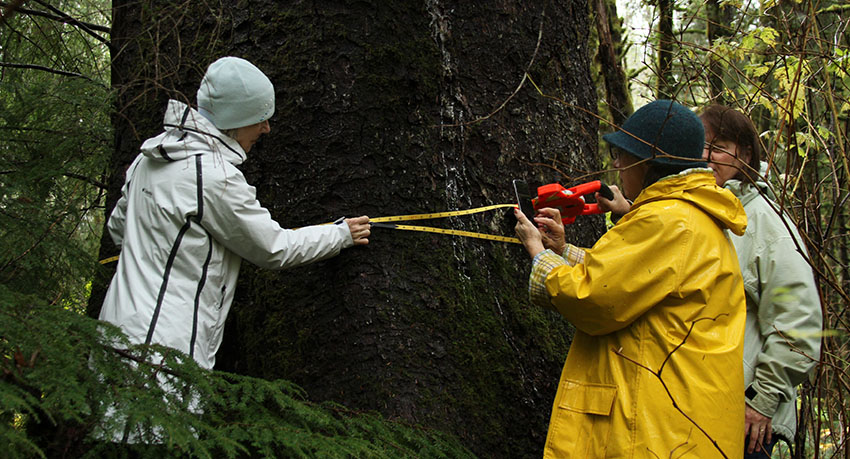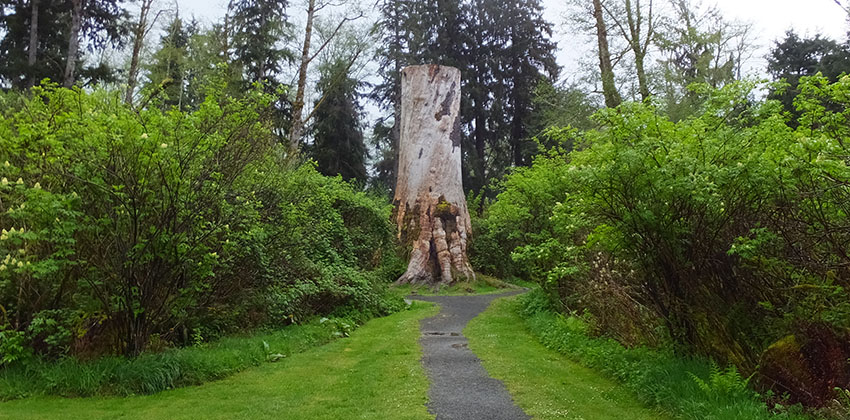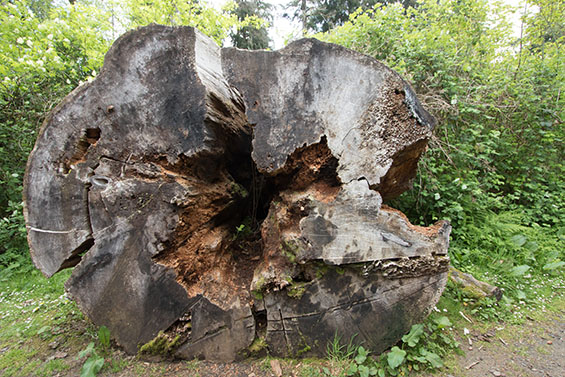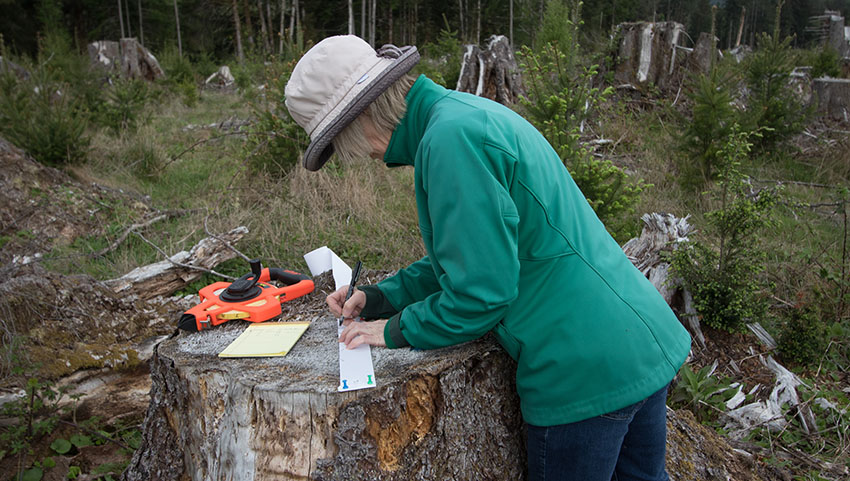NCLC supporter Jeff Roehm has shared another essay with us, this one about a project that naturalist and NCLC founding executive director Neal Maine dreamed up to estimate how many years it will take for one of the big Sitka spruces now growing at Necanicum Forest Habitat Reserve to be as big as the famous Klootchy Creek Spruce. The Tree Measuring Team recently returned to the forest—in more favorable conditions—to take more measurements and move the project forward.

Sharon, Pat, and Jeanne measure the circumference of a Sitka spruce in Necanicum Forest Habitat Reserve.
One day late last fall I was sitting in my car outside the post office in Gearhart, waiting for Neal Maine and three other friends, Pat, Sharon and Jeanne, to show up. They were all heading out to an NCLC habitat reserve called Necanicum Forest and had invited me to join them. The story was that the women were going to help Neal measure some trees—they were the Tree Measuring Team, as it were—and I was being added. I wasn’t sure what that was all about, but it sounded like fun, even if it was pouring down rain. This apparently doesn’t stop the coasties. At any rate, it’s nice to have friends that will invite you to come along, in the rain, to their next adventure.
I’d been out to Necanicum Forest twice last summer with my pals the Wednesday Weed Warriors, cutting Japanese knotweed away from the riverbank. I even brought along my grandson Caden the second time. This is not a place most people get to see, since it’s about a mile down a private logging road behind a locked gate. You basically have to volunteer to pull weeds or some such thing to go there. We must have been up to our eyeballs in knotweed those two days, because I didn’t notice the trees at all. This time the plan was to look around a little more carefully and see what this was all about.
Necanicum Forest is just a couple of miles up Highway 26 past the Cannon Beach junction south of town in an area called Klootchy Creek. I say an area, because the creek itself, a tributary of the Necanicum River, is a little hard to find. If you drive by, you see a one-way bridge across the Necanicum, a little county park, some farms, lately some homes, and historically a whole lot of really big trees. I’d been out there many times since one of the kids in my neighborhood, Butch Mulligan, had moved out to a farm just across the highway from the park. It was a wonderful place for a kid to goof around.

If you stop at Klootchy Creek County Park today, you can see the remains of what was once considered the largest Sitka spruce in the world. Interpretive signs lead visitors through such trees’ life cycle. Neal wonders if it’s now the world’s largest Sitka spruce stump?
But this place is really all about the trees. I think it’s just one of those spots that was just out of reach of those first railroad loggers: a relatively flat area protected from the big winds. The largest of these trees was known as the Klootchy Creek Spruce, sitting right in the center of the 25-acre park. It broke in half in 2007 and is now probably the biggest stump and woody debris in the country. Before that it was arguably the largest Sitka spruce on the planet, only just over 200 feet tall after being broken off by wind long ago, but 17 feet in diameter. Age estimates are difficult, but recently I’ve read that the best guess is that it first took root in the year 1218 (probably on a Tuesday). Well, OK, that would have made it 789 years old when it finally came down!
Growing up in Seaside, I don’t really remember that tree much, because there was an even more famous larger tree on a hillside just up the gravel road that runs through the park. This one, known as the Clatsop Fir, was a Douglas-fir discovered in 1938 that was 210 feet tall (also with a broken top) and 15.8 feet in diameter. Not so tall as Doug firs go, but supposedly the world’s largest by volume. I remember being out there at the base of the tree at least twice before it blew over in the Columbus Day storm of 1962. The Seaside Historical Society has its age at 702 years.
So there you have it. A spruce tree takes root, perhaps just three years after King John signs the Magna Carta. A second tree, a little fir up the hill, sprouts later that same century. Both are blown down within fifty years of each other seven centuries later, a testament to how effective it is to save a tree (or two) and cut down the rest.

When the top blew off the big spruce, the snag was then cut down in pieces; this is one of those pieces, on display at the county park. The center was already rotten; now the rest of it is slowly decomposing, the next step in its life cycle.
But these two trees are only part of the story as far as I’m concerned. The Seaside I grew up in was a logging town, and among the locals, Klootchy Creek was the home of the biggest, best-est logging shows in the county. I worked for Crown Zellerbach, the owner of all those trees, during summers while I was in school. I remember my first year out there in 1960, walking through the forest with the head engineer, Jim Ellison, helping survey the route for a new logging road. Even as a young kid of the times, I was awed by what I saw. It was, as they say, like walking through a cathedral. These were huge trees, every tree reaching straight to the sky, the sun only peeking in as through a stained glass window, never to reach the forest floor. I remember the sinking feeling realizing we were about to cut all of this down. As all of my people know, I love trees, and this may have begun as I walked through the woods at Klootchy Creek.
Now back in my car in Gearhart, I looked out through the rain on my window. Ah, there’s Neal! So out I go and climb into his front seat to wait for the rest of the TMT to arrive. Neal: “We’re going out to that fantastic piece of land at Klootchy Creek. It’s hunting season, so the gate will be open.” Well OK, wind and rain, and a fantastic piece of land. This is going to be good. Here come the women.
So now with a complete crew, we all piled into Neal’s car and headed for the trees. One of the neat things about my hometown is that nothing’s really very far away. So after just a few minutes’ drive, Neal pulled into Klootchy Creek County Park and then followed the Necanicum Mainline (the gravel road) about a mile. We were here. The Necanicum Forest Habitat Reserve is the next property upstream (southeast) from the park. A few minutes fussing around with boots, raingear, and cameras and we were off along the trail that leads through the reserve to the Necanicum River. The reserve is just 28 acres, but it’s long and narrow on the north end with a full half-mile of riverfront.

Close-up of growth rings in one of the index trees that the Tree Measuring Team found in a nearby clearcut. Wide and narrow rings tell a story of large and small growth years.
Like I say, I’d been here twice before, but this time I was looking around. We were on what felt like an old road grade, but things were pretty flat everywhere, and solid. I was thinking that we were walking through an area that had spent a lot of its life as part of a meandering riverbed. It was a forest all right, but not one filled with trees growing in close ranks. Then as we walked along I began to see them. Very large Sitka spruces were scattered through the forest, not together but growing singly perhaps 100 to 150 feet apart, with their crowns extending down almost to the forest floor. They had been more or less in the open all of their lives. The smaller trees were mostly western hemlock. But once you saw the spruces, you couldn’t take your eyes off of them. These were the trees Neal was here to measure.
The fascinating idea was to measure the size of a tree, then its distance from the water, and estimate its age. Then you could extrapolate out, figuring when in the distant future it might reach the size of the Klootchy Creek Spruce over there in the park. This is what we’d gotten ourselves in to, out here on a rainy day in November.
The description of this reserve states that it’s a second-growth forest. That is, this place has been logged once before. I’d love to know the details of that. I don’t remember any stumps to speak of, certainly no old-growth stumps, and not much woody debris on the ground. And these spruce trees: what about them? The most common question I get asked about trees is, “How old do you think this is?” That’s one of the things that make trees so cool. Small saplings in an understory are sometimes more than fifty years old, and then there are those really big ones. So what about these? That’s a really, really good question.
But that’s why the TMT had been formed, to help Neal answer just that question. So now our fearless leader (it was windy) selected what was supposedly the largest spruce, and the team set to work with a long tape measure. The goal was to measure the tree’s circumference. If you’re a forester, this should be at breast height, but we do what we can. So let’s find some way to get the tape around the tree, keeping it more or less level, and then back to the starting point to mark the distance. The tree was huge and the area around the base rough, brushy and uneven. The measurement, more or less, was impressive, but perhaps the subject of another report down the line somewhere. Neal stood back behind his camera and tripod, while I tried to look busy. I’m good at that.

Sharon is counting and measuring growth rings on this index stump. They’ll correlate the average number of rings with the tree’s width and start to get clues to how long it will take for a tree already growing in Necanicum Forest Habitat Reserve to become the size of the record-setting tree in adjacent Klootchy Creek County Park.

By measuring fat years and lean years, the TMT can estimate the average size of a growth ring.
When the TMT had finished, Neal spotted another tree about 100 feet away that he thought might be bigger. There was only one way, really, to find out. This time the team was more practiced. After a shorter and easier time, the result was that the two trees were almost exactly the same size. This may have led to the premature conclusion that all the trees were essentially identical. The TMT was ready for more, but we had run out of time. Other duties back in Seaside were calling.
I looked around. That’s really why I was here. We talk a lot about time at the trust, how we’re in this for the long haul. In this respect, this place is really special. I thought about these trees growing through time to become the size of the Klootchy Creek Spruce. Wouldn’t that be amazing! After cutting down those trees of my youth, we might just owe them the chance.
As we started back out on the trail to the car, I was still looking at trees. Then there it was, off to the left, up against a grove of smaller trees, the most beautiful, tallest, best tree in the Necanicum Forest, trust me. I turned to Neal: “Look at that.” And from Neal, “I think we’re going to have to come back.”
Thinking about that day, I’m pretty sure most Seasiders have heard the words Klootchy Creek, and in their foggy memory know where it is and are sure they’ve seen it. But that’s really not very likely. There’s water flowing past the county park that bears that name, but that’s the Necanicum River, not the creek. So just where exactly is it? That special honor is held at a spot about a mile upstream from the bridge at the park, back away and hidden from the highway. Our beautiful, reclusive little creek, famous for its big trees, flows out of the hills to the north and then for its last quarter mile through an NCLC habitat reserve called Necanicum Forest. You can stand on an old bridge in the center of the reserve, just a few feet from where we measured our trees, and watch it flow under your feet. If I had a vote, we’d call that beautiful spot Klootchy Creek Habitat Reserve.

Necanicum Forest Habitat Reserve in 2013, three years after the property was acquired by North Coast Land Conservancy
Comments